From the intricacy of a microbe to the majesty of a redwood, it’s obvious that Mother Nature is a fine engineer. But in some cases chemists think they can do nature one better. Take the common leaf.
In many ways the leaf is a marvel, capable of pumping out hundreds of precisely crafted biochemicals. Leaves also allows plants, through photosynthesis, to “eat” sunlight by converting solar energy to chemical energy—the basis of the entire food chain.
But even the fastest-growing and most efficient plants (sugar cane, corn) use just 1% of incoming light, reflecting or squandering the rest. And many of the biochemicals that leaves make are noxious—bitter compounds to discourage animals from nibbling.
For those reasons scientists are trying to reimagine the leaf. So-called artificial leaves try to outdo photosynthesis by capturing more solar energy. And parallel work on “bionic leaves” aims to harness the biochemical machinery of plants to manufacture fertilizer, monitor environmental threats, and even mine precious metals.
In essence photosynthesis splits water molecules into H2 and O using chlorophyll. Plants then fuse H2 to CO2 in various ways to make chemical fuels, such as sugar. Of the two steps the first is much harder and more energy intensive.
In the lab platinum can be used to split water molecules fairly easily, but the metal’s high cost limits its use in industry. Only in the past decade, with the emergence of cheap cobalt-phosphorus catalysts, has artificial photosynthesis become cost-effective. When coupled with the right electronics, the catalysts can use a full 10% of the sun’s rays to cleave water molecules.
To be sure, calling these systems “artificial leaves” is something of a misnomer: the equipment looks less like a green, papery maple or oak leaf and more like a black postage stamp. Moreover, to actually make chemical fuel scientists have to feed the liberated H2 to bacteria for further processing.
But no matter the name artificial leaves hold immense promise for our planet’s future. Not only would they allow us to store transient solar energy for future use—a big shortcoming with current solar panels; they can help scrub CO2 from the air, in a small way lowering levels of the greenhouse gas.
There’s no reason to stop with biofuel either. Some bacteria can use the H2 from artificial photosynthesis to make cheap plastics or drug precursors. Others can combine H2 with nitrogen from the air to make ammonia-based fertilizers, which they then deliver directly and efficiently to the plants’ roots. In preliminary tests radishes grown with bacteria-made fertilizers outweighed a control group by 50%.
Some scientists have taken a different approach. Instead of creating wholly artificially leaves, researchers tweak leaves bionically to give them superpowers. An MIT team, for instance, has engineered spinach to detect bombs.
The scientists began by injecting carbon nanotubes into the leaves of spinach plants. The nanotubes were coated in a polymer sensitive to picric acid, a common ingredient in explosives. If any picric acid is present in the soil—from, say, a forgotten land mine—these plants will absorb it and circulate it to the leaves, where it binds to the polymer. This changes the optical properties of the polymer, allowing it to fluoresce: simply shine a laser on the leaf, and it will glow in the infrared, something easily observable with detectors. By swapping in different polymers scientists can rig leaves to detect TNT, the nerve gas sarin, and other toxins as well.
Because the binding between polymers and target chemicals happens so quickly—in as few as 10 minutes—bionic plants could also find use in industry someday, as a quick, cheap way to monitor for leaks near storage tanks and other equipment. Farmers could even use them to anticipate droughts since dry spells cause chemical changes in the soil that plants notice far sooner than humans.
But why stop at simply detecting bad things? Why not use plants to clean them up as well? Tobacco plants naturally absorb radioactive elements, such as polonium; a few genetic tweaks could expand their janitorial duties to mercury and other heavy metals. Better still, some scientists have proposed converting plants into miners that extract precious metals. We could even begin “mining” the sea: the oceans hold 20 million tons of dissolved gold, and properly modified seaweed or kelp could filter and concentrate it for easy extraction.
However inert they appear, plants are brilliant chemists, constantly sampling and analyzing the solids, liquids, and gases around them. Bionic and artificial leaves simply use science to extend their talents a little further—Mother Nature and human nature working hand in hand.




